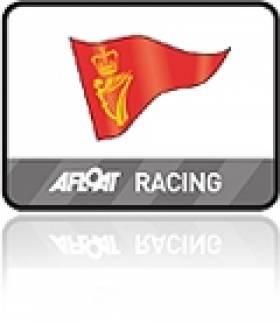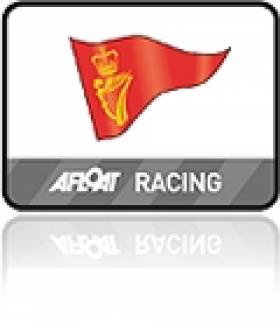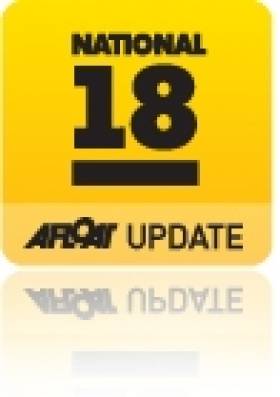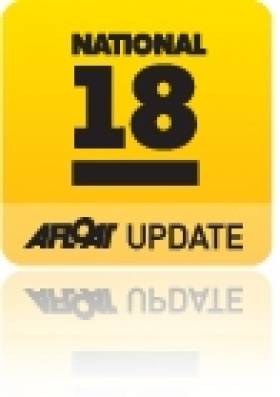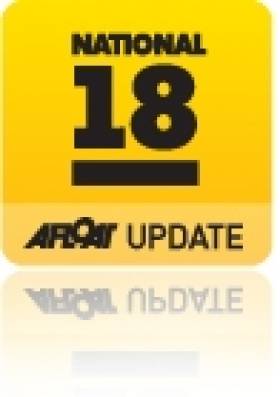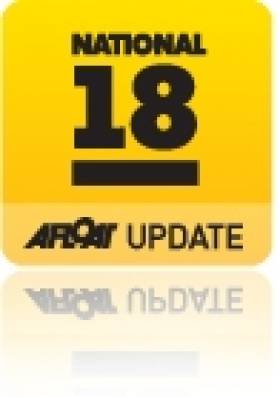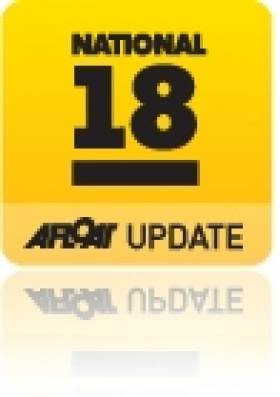Displaying items by tag: National 18
#rcyc – At yesterday's RCYC 'At Home' Regatta, Admiral Pat Lyons took the opportunity to highlight numerous Royal Cork YC championship winners from the Club in 2014 writes Claire Bateman. To underline this point, almost as Pat Lyons was speaking, a further winner was announced when top Cork Harbour youth Johnny Durcan lifted the 4.7 class title at the Irish Laser Nationals on Belfast Lough.
Racing started in a south westerly breeze for day two of MSL sponsored Regatta With the sun shining in the morning, it produced sparkling sailing conditions for the National 18s who were having their South Coast Championships as part of at the At Home weekend.
Not so lucky were the dinghy fleets sailing on the Curlane Bank as the forecast cloud arrived overhead providing what photographers call slack light. The sun was there but behind the clouds. However, the stable breeze made for great racing on the day.
By the time the sailors had returned from racing the patchy mist and light rain had begun to make its presence felt but this did not deter them and the general attendance from enjoying the superb afternoon tea of sandwiches and scrumptious cakes aplenty and then on to enjoy the various activities. The children took the crab fishing competition very seriously and stood over the measurer, Stuart Daly while he carried out the onerous task of measuring the crabs while minding his fingers. There was face painting, a tug o war for the young sailors with the girls team showing their prowess to beat the boys. There was the serious business of the Boules match for former Admirals and the current Admiral, cheered on by the large attendance and then on to the prize giving.
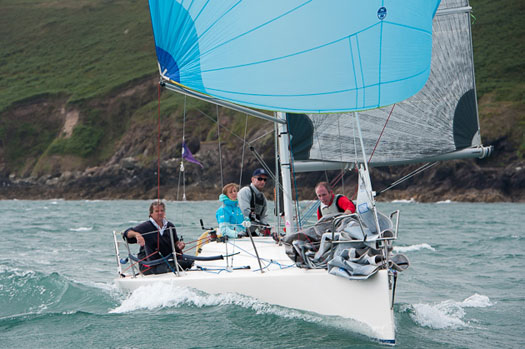
Admiral Pat Lyons thanked the Sponsors, MSL Motor Group and he highlighted in his speech the number of championship winners from the club and pointed out that even today we had two further winners when Johnny Durcan won the 4.7 class at the Irish Laser Nationals. Rebecca O'Shaughnessy took First Lady in the 4.7 class and Cian Byrne took second place in the Radial Class.
The Admiral then presented all the many prizes and trophies with assistance from Rear Admiral Keelboats, Kieran O'Connell, and Rear Admiral Dinghies, Celine McGrath. Then at the conclusion of the prize giving as the rain and wind had become more pronounced and all the events had successfully taken place, the good humoured attendance started to make their way home having had a thoroughly enjoyable At Home at the club.

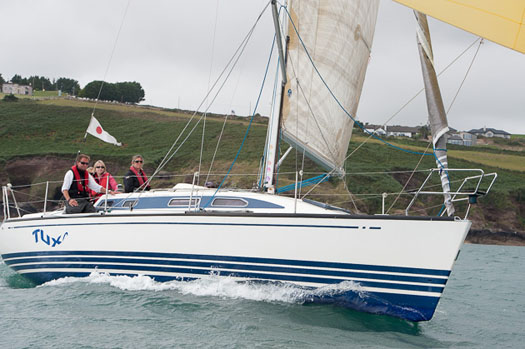
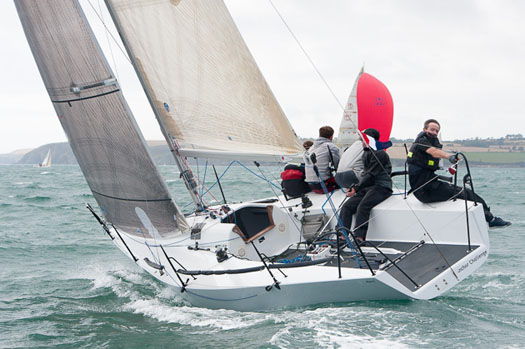
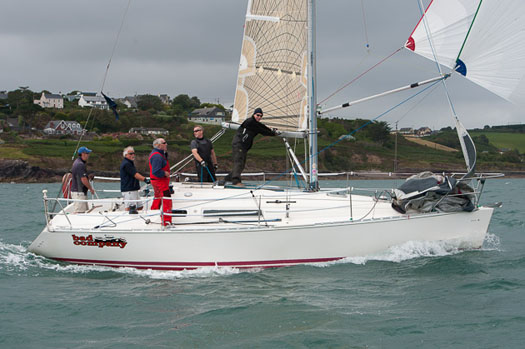
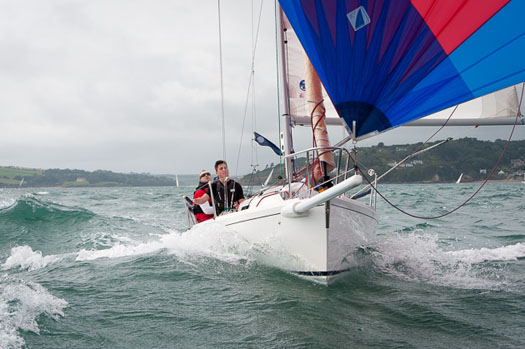
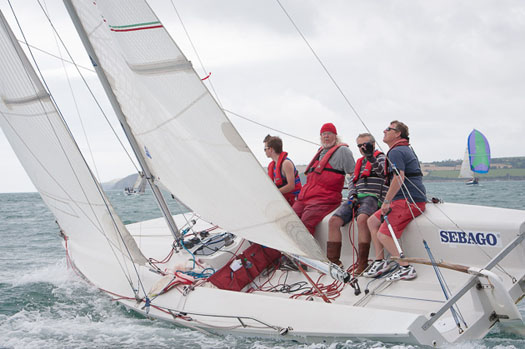
#rcyc – Once again Royal Cork Yacht Club is very proud to welcome back the prestigious sponsorship of the MSL Motor Group for the annual At Home Regatta weekend writes Claire Bateman. The club is looking particularly resplendent with the latest Mercedes models on display and with the Mercedes flags and colourful bunting throughout the grounds there is a particularly festive atmosphere around. The At Home weekend is one of the highlights of the year at the Royal Cork Yacht Club when members and their families gather to renew old acquaintances, meet new friends and simply to enjoy a great weekend.
All ten of the National 18s were sailing for the South Coast Championship and as usual they were going hell for leather with no quarter sought nor given. Over twenty cruisers including 1,2,3 and whitesail got in a great day of racing. While in the dinghy fleets there were four Fevas, five Toppers, five Lasers and more Optimists than one could count.
Prior to racing proper some of the younger sailors were brought out for practice in the river and given the wind strength they sailed with reefed sails, not a thing one would see very often. However, the highlight was to see the two Topaz dinghies named 'Christine' and 'Spellbound', so generously donated to the Club by Dr. Raymond Fielding, standing out in their performance ahead of the dinghy fleet.
Racing will continue tomorrow (Sun) and no doubt there will be a scramble ashore after racing to partake of the programme of festivity and to enjoy the usual scrumptious afternoon tea kindly organized by the Admiral's Lady Ann, and her band of willing helpers.
National 18 Book Launch In Cork Tonight
#National18 - Here's a reminder for your diary that the official book launch of Brian Wolfe's history of the National 18 will take place tonight (11 December 2013) at 7.30pm at the Royal Cork Yacht Club.
The book documents 75 years of the boat's legacy on Irish waters, from its timber beginnings in the late 1930s to the fibreglass developments three decades on, with some 800 images across its more than 200 pages.
Wolfe has also painstakingly researched and compiled all of the boats championships and sailors across the Ireland and the UK, making this book a must for any sailor's library.
And with the gift-giving season in mind, the book is available in a limited collectors' hardback edition of just 378 copies, signed by the author, priced at €55 (plus P&P) - 378 being the number of boats registered in the history of the class.
Wolfe will be joined tonight at the launch reception by Eithne Payne and renowned marine writer Tom MacSweeney.
National 18 foot Dinghy Book To Be Launched at Royal Cork Yacht Club
#natiional18 – The Official launch of the National 18 foot Dinghy book by Brian Wolfe will take place at a reception at the Royal Cork Yacht Club on December 11th, 2013 at 7.30pm writes Claire Bateman. The book documents the fascinating history of this popular dinghy's 75 year history.
The book will be launched by well known marine writer Tom MacSweeney with Eithne Payne and Brian Wolfe.
This book is an essential in any sailors, boat restorers or builders library. It details all of the Championships and sailors who were and are involved with the class during its great history. It is a fascinating and beautifully produced book and woud make a wonderful Chrismas present.
National 18 Prototype Moves to UK For Further Evaluation
Following Afloat.ie's recent coverage of the new National 18 design and her maiden sail in Cork, there have been extensive trials undertaken with over 50 people in Cork harbour sailing her in the past number of weeks. The protoype is now moving on to the UK for the next few months to determine a path for the future of the class.
The National 18 is unique as it is the only three person centreboard dinghy of its size currently on the market.
Originally developed in 1938, the class has gone through a number of developments over the years from fibreglass boats, aluminium masts, lighter hulls and most recently carbon masts. Unchanged for 20 years, the latest evolution of the class was developed this year. Sailors in the fleet from both Ireland the UK, recognised the boat needed modernising in terms of weight, speed and its broader appeal to younger sailors, and men and women alike.
To understand and assess all of the options available to the class in the modern era a new National 18 prototype was launched. The prototype boat, named "Odyssey" and designed by Phil Morrison, is a modern interpretation of the class rules originally conceived by Uffa Fox. The new boat retains the modern rig but has taken some big steps forward in hull design. She is lighter, faster, more stable and safer in a capsize.
One of the big difference is hull shape and weight. These boats are 50kgs lighter with a chined hull. The hull of the prototype matches the performance of the rig better. The loads have been significantly reduced and combined with better performance have created a much more stable boat to sail.
The design has transformed the look and feel of the National 18 class and has been warmly welcomed so far. The class have recently completed six weeks of engagement sessions in Cork with more than fifty sailors of all ages and both genders enjoying the National 18 Prototype in 2-30 knots of wind.
The project now moves to the UK where the team have an excellent itinerary over the coming months visiting all the current active National 18 clubs in England and Scotland and entering targeted events such as the Sailjuice series to put her through her paces.
History of the National 18' Dinghy to be Published
#national18 – The History of the National 18' Dinghy written by Brian Wolfe will be published shortly.
Although the class once enjoyed pockets of enthusiasm in Ireland at Skerries, Portrush, Strangford Lough and Dunmore East, these have faded away and so the class only remains in Cork Harbour where it has always maintained a very strong presence since introduced there in 1939. The painting on the front cover, by local Cork artist Tadhg O' Scanaill is of legendary helmsman Somers Payne and Melody (206). Somers also represented Ireland in two Olympic Games.
The book covers the history of the class, which celebrated its 75th anniversary this year, on both sides of the Irish Sea and also includes a boat register. The development of the new 18' design at Crosshaven is also featured. The 2013 National (British and Irish) Championships were raced at Hayling Island on the south coast of England when Corkman Tom Dwyer won for the fourth occasion. The author's father Alan Wolfe, as a member of the Crosshaven club, was twice a National Champion in the 1960's.
National 18 Protoype Cuts a Dash in Cork Harbour
#National18– Have a look at the new prototype National 18 dinghy, looks stunning! The Phil Morrison type got a great reaction when laucnhed yesterday for the CH Marine sponsored Royal Cork Autumn league writes Claire Bateman
Showing true Morrison lineage the boat was built by Ian Teasdale in Devon. Scroll down for more photos below by Bob Bateman.
Pundits say she looks like a cross between an RS400 and a Mark 8 International 14.
Early reports suggest she should be more forgiving to sail downwind in a blow but she might be a little tricky to compete against the existing boats upwind in light airs.
Royal Cork's Peter O'Donovan gaves his verdict on the National 18 facebook page. 'Went out in the trial boat today. It was light enough weather but really a lovely boat to sail. Fantastic space in her too. We tested her in the capsize and one man managed to right her on his own while the rest of us watched in the rib'.
Helming the new development craft is long time RCYC member Dom Long with crew Colin Chapman and Kieran Dwyer.
Along with other recent innovations, such as carbon rigs, the the prototype is to be trialed and a decision taken at next AGM (next summer) on her future!
"Early reports suggest she should be more forgiving to sail downwind in a blow"
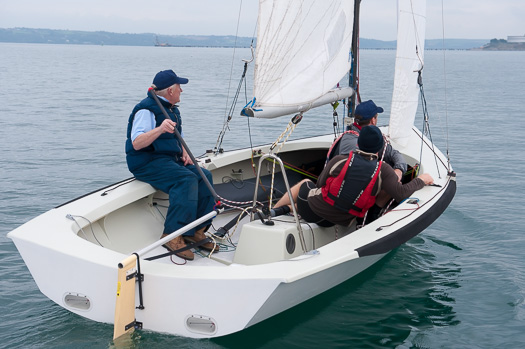
The new boat has an old rig (below), is it big enough for that wide stern, could it use a square top rig?
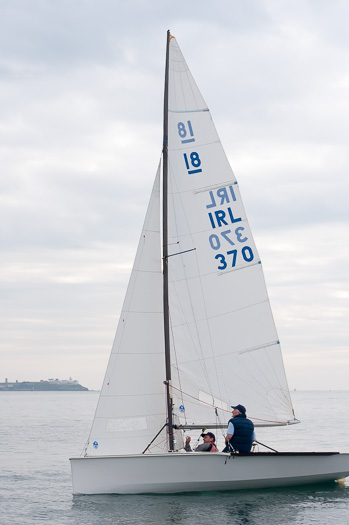
The newest National 18 on trial. The class will vote on the development next summer. What's next for this successful Irish class? Could they go the whole hog, put racks on her, twin trapezes and turn her into an 18ft skiff?

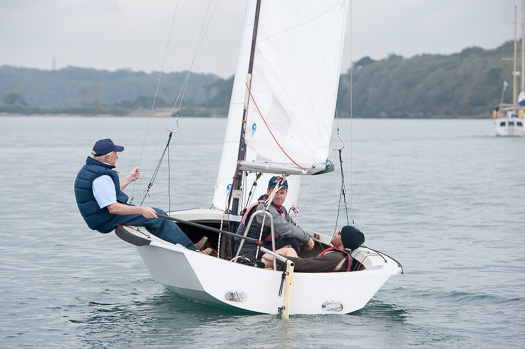
#national18 – Colin Chapman and his team on "Aquaholics" No 370, with a lead of 7 points after discard, have comfortably won the 2013 Irish National 18 Championships hosted by the National Yacht Club in Dun Laoghaire over the weekend.
Full results are available to download below as a jpeg file.
15 teams competed. 2nd was Nick Walsh in "Three Blind Mice" No 372 followed closely in 3rd place by Andrew Moynihan in "Happy Days" No 358.
It is the first time since the 1960's that the National 18s have hosted their Championships in Dublin and they enjoyed boisterous conditions on both days with superb race management lead by Jack Roy and his very able team. 3 races were held on Saturday in demanding conditions, which included gusts from the North West up to 30 Knots, which caused multiple capsizes for most of the teams and a shortening of race 3.
After a day of exhilarating close racing, Colin Chapman and Bryan Hassett in "Cleo" No 342 were tied on 8 points. Despite the exhausting conditions and resultant weary bodies, the National 18 Fleet enjoyed its usual vibrant evening's entertainment on Saturday evening which continued into the early hours of Sunday morning.
The expected lighter conditions on Sunday quickly changed to more of the same blustery and shifty winds but now blowing 15 to 20 Knots from the South East with a spring flood tide creating the usual awkward Dublin Bay chop. Jack Roy elected to race in Scotsman's Bay using a traditional triangular Olympic course format which provided reaches which were unbelievably fast resulting in several high-speed capsizes.
Nick Walsh played a blinder to win the first race and followed this up with 2 second places in race 5 and 6. Colin Chapman score a second which he then followed up with 2 close wins in a great demonstration of skilful boat handling in the tough conditions. Peter O' Donovan, in "Muchadoo" No 350, after a good 3rd in race 4 to put him in contention suffered a snapped rudder whilst in the leading bunch during race 5 putting an end to his late charge. Bryan Hasset slipped out of contention with a capsize in race 4 when a severe 25 Knot gust materialised whilst executing a gybe on the first run..
Throughout the weekend, despite the conditions, racing between all the boats was very close with often 3 and 4 boats simultaneously arriving at marks at speed.
The consensus amongst the competitors was that it was an outstanding event and they looked forward to returning in the near future to once again enjoy the hospitality of the National Yacht Club.
National 18s Set Sail for Irish Title on Dublin Bay
The National 18 class travelled from Cork to Dublin Bay this weekend for the Irish championships, the first time since the mid 1960's that this exciting trapeze class has held its Championships in Dublin.
The National Yacht Club is hosting the class in Dun Laoghaire harbour with competition starting today. Picture gallery above by Aidan Tarbett.
As previously reported on Afloat.ie the National 18 is a 3 person boat with essentially a one design GRP hull shape, with a large sail area flown on a carbon rig with one crew member using a trapeze.
They have an exhilarating performance being quicker than a Dragon upwind with 'gobsmacking speed downwind' in any sort of a breeze. The fleet is peppered with quality sailors including former and current Olympians.
Racing is lively, close and ferocious with the boats all matched with similar speed.
Dublin to Host Top Cork Dinghy Championships
#national18 – The National Yacht Club in Dun Laoghaire will be hosting the National 18 Irish dinghy sailing Championships, the first time since the mid 1960's that this exciting trapeze class will hold their Championships in Dublin.
The event will be held at the NYC from 15th & 16th June 2013.
The traditional stronghold for 18 sailing is based in Crosshaven and Monkstown in Cork where an active fleet of over 30 boats enjoys close racing on a weekly basis. They are a 3 person boat with essentially a one design GRP hull shape, with a large sail area flown on a carbon rig with one crew member using a trapeze.
They have an exhilarating performance being quicker than a Dragon upwind with gobsmacking speed downwind in any sort of a breeze. The fleet is peppered with quality sailors including former and current Olympians. Racing is lively, close and ferocious with the boats all matched with similar speed.
The hosts confidently expect a fleet of 25 boats to participate, augmented with entries also attending from some of the hotspots for 18 sailing in the UK. The fleet will have a division for Classic 18s, some of which are well over 60 years old and beautifully restored with their original clinker planking and wooden masts.
The photo of Fingal 226 below is of one of the famous rule bending so called "sticky" Parker (The famous UK builder of world beating 505s) built plywood boats constructed for Jack Flannagan of Skerries in the 1960's when the event was last held in Dublin.
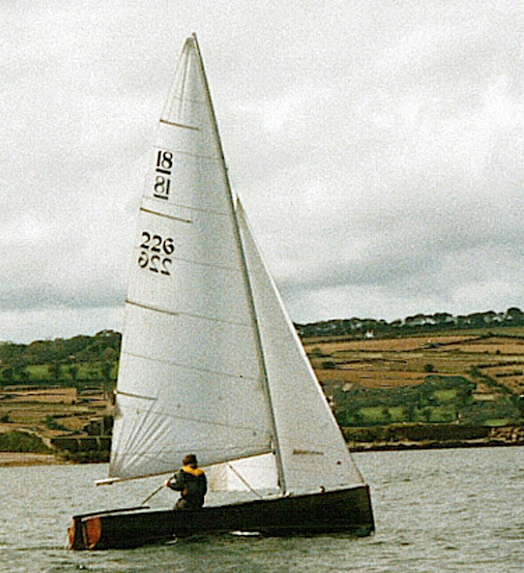
Both this boat and Finola 227 a sister ship built for Jack's brother, the famous Leo Flannigan, have been restored by enthusiastic owners to brand new condition and are still actively sailing in their original 1960's configuration. These outstanding boats being built of glued plywood planking, completely eclipsed the then commonplace traditional spruce planked boats and ultimately led to the adoption of the Proctor designed GRP smooth hull, which is still used today.


























